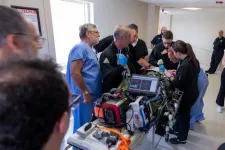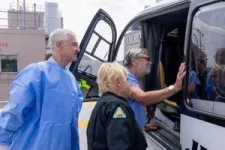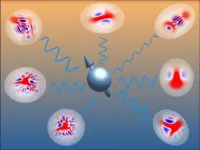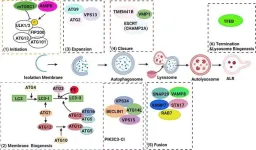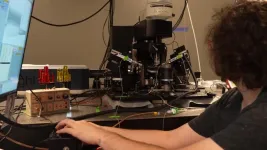(Press-News.org) For the first time, a closed loop, autonomous intervention nearly quadrupled the “golden hour” during which surgeons could save the life of a large animal with internal traumatic bleeding while in emergency ground and air transport.
This breakthrough in trauma care, announced today in Intensive Care Medicine Experimental by physician-scientists at the University of Pittsburgh School of Medicine and funded by the U.S. Department of Defense, has enormous potential for saving the lives of traumatically injured members of the military harmed in remote battlefields or civilians injured in mass casualty events or rural locations far from advanced medical care.
“Under normal conditions, if we can get somebody with severe trauma to the hospital within an hour, there’s a good chance that we can save them,” said the project’s scientific lead Michael R. Pinsky, M.D., professor of critical care medicine, bioengineering and clinical and translational medicine at Pitt. “For the first time in the history of medicine, we took an animal in a critical state onto a helicopter and autonomously brought it back healthier than when it was placed in emergency transport hours earlier. The implications this has for treating people in the field with trauma are phenomenal.”
The multidisciplinary Pitt team, assisted by computer scientists from Carnegie Mellon University, tested a key component of the Trauma Care in a Rucksack (TRACIR) system, designed to fit inside a backpack that could be delivered by drone to remote locations. The minimally invasive, closed loop algorithm, called Resuscitation based on Functional Hemodynamic Monitoring (ReFit), autonomously gave intravenous fluids, blood and drugs to maintain vital functions in pigs with a traumatic lethal liver injury for three to five hours without human intervention, while they were transported by ground ambulance and helicopter and finally returned to the laboratory surgical suite as a demonstration project.
On different days, a total of four fully anesthetized pigs – whose anatomy and response to traumatic injury closely resembles that of humans – underwent surgical liver laceration in a laboratory surgical suite under approved animal research guidelines. They were allowed to hemorrhage for 30 minutes before being resuscitated with the ReFit computer algorithm system, which is about the size of a microwave. Once the autonomous resuscitation device was turned on, the pigs received no medical intervention from a human beyond monitoring by an emergency medicine doctor to ensure they remained fully anesthetized and in no discomfort.
Two of the pigs, connected to ReFit, were placed on a stretcher and moved by emergency medical technicians to a hospital helipad where a medical helicopter flew them around Western Pennsylvania for several hours to mimic an emergency rescue from a remote location. The other two were transported first by ground ambulance to the Allegheny County Airport where they were then loaded onto a medical helicopter and flown back to the hospital helipad over similarly prolonged flight paths to simulate long distance transport.
Once returned, the research team confirmed that they could resuscitate the anesthetized pigs autonomously for several hours without human intervention using only a computer-generated autonomous care algorithm.
“By keeping these animals with a lethal injury alive for up to five hours with a computer driving the resuscitation, you can see how that extends the golden hour,” said principal investigator Ronald Poropatich, M.D., director of the Center for Military Medicine Research and professor of medicine at Pitt. “We are excited about the potential to soon apply this technology to saving the lives of people injured in austere environments.”
The team’s next step is to test transporting ReFit-connected injured animals by unmanned aerial drones to make the process even more effective for rescuing injured people in difficult-to-access locations, such as a mountainside or a military battlefield.
Additional authors on this research are Hernando Gomez, M.D., Francis X. Guyette, M.D., Leonard Weiss, M.D., Lisa Gordon, Theodore Lagattuta, and David Salcido, Ph.D., all at Pitt, and Artur Dubrawski, Ph.D., Jim Leonard, and Robert MacLachlan, all at Carnegie Mellon University.
This work is supported by the US Army Medical Research and Materiel Command under Contract No. W81XWH-19-C-0101 and W81XWH-19-C-0083.
The views, opinions and/or findings contained in this report are those of the authors and should not be construed as an official Department of the Army position, policy or decision unless so designated by other documentation.
In conducting research using animals, the investigators adhered to the Animal Welfare Act Regulations and other Federal statutes relating to animals and experiments involving animals and the principles set forth in the current version of the Guide for Care and Use of Laboratory Animals, National Research Council.
END
Autonomous medical intervention extends ‘golden hour’ for traumatic injuries with emergency air transport
2024-05-24
ELSE PRESS RELEASES FROM THIS DATE:
More than spins: Exploring uncharted territory in quantum devices
2024-05-24
Many of today’s quantum devices rely on collections of qubits, also called spins. These quantum bits have only two energy levels, the ‘0’ and the ‘1’. However, spins in real devices also interact with light and vibrations known as bosons, greatly complicating calculations. In a new publication in Physical Review Letters, researchers in Amsterdam demonstrate a way to describe spin-boson systems and use this to efficiently configure quantum devices in a desired state.
Quantum devices use the quirky behaviour of quantum ...
SG ramps up cancer fight with S$50 million in national grant funding for precision oncology
2024-05-24
Singapore, 24 May 2024 – Two multi-institution and multidisciplinary Singapore teams of clinician-scientists and researchers have been awarded grants of S$25 million each, by the Singapore Ministry of Health through the NMRC Office, MOH Holdings Pte Ltd, under the NMRC Open Fund-Large Collaborative Grant (OF-LCG) programme. The S$50 million support for cancer research establishes the SYMPHONY 2.0 and Colo-SCRIPT research programmes to drive precision oncology research in Singapore aimed at improving the understanding, diagnosis and treatment of lymphoma and colorectal cancer.
Led by the ...
Autophagy in pancreatitis
2024-05-24
Researchers are exploring a new potential avenue for pancreatitis treatment: autophagy, a cellular recycling process. Autophagy helps maintain healthy pancreatic acinar cells by removing damaged organelles like mitochondria and the endoplasmic reticulum (ER).
A new review published in eGastroenterology highlights the link between defective autophagy and pancreatitis. Impaired autophagy contributes to pancreatitis by allowing damaged organelles to accumulate within acinar cells. This accumulation disrupts cellular function and can ultimately lead to cell death.
"Autophagy plays a vital role in keeping pancreatic acinar cells healthy," ...
To 6G and beyond: Penn engineers unlock the next generation of wireless communications
2024-05-24
In the early 2010s, LightSquared, a multibillion-dollar startup promising to revolutionize cellular communications, declared bankruptcy. The company couldn’t figure out how to prevent its signals from interfering with those of GPS systems.
Now, Penn Engineers have developed a new tool that could prevent such problems from ever happening again: an adjustable filter that can successfully prevent interference, even in higher-frequency bands of the electromagnetic spectrum.
“I ...
USF researcher using VR to map the brain, understand and treat disorders such as autism
2024-05-24
TAMPA, Fla. (May 24, 2024) – Through high-tech imaging and virtual reality, a University of South Florida medical engineering professor is creating a detailed map of the brain that can be used to better understand developmental disorders, such as autism, and provide earlier, more effective treatments for brain injuries and diseases.
Funded by a $3.3 million grant from the National Institutes of Health, George Spirou is expanding on his four decades of brain research to focus on the part of the brain that ...
Semaglutide significantly reduces risk of major kidney disease events, cardiovascular outcomes and mortality in patients with type 2 diabetes and chronic kidney disease, groundbreaking study reveals
2024-05-24
Semaglutide significantly reduces risk of major kidney disease events, cardiovascular outcomes and mortality in patients with type 2 diabetes and chronic kidney disease, groundbreaking study reveals
A pioneering study has demonstrated that semaglutide significantly reduces the risk of major kidney disease events, cardiovascular outcomes, and all-cause mortality in patients with type 2 diabetes and chronic kidney disease.1 The landmark trial, presented today at the 61st ERA Congress, will pave the way for new treatment strategies and ...
Unveiling a novel AAK1 inhibitor: How chemical proteomics unlocked therapeutic potential
2024-05-24
Enhancing drug development for life-threatening diseases like cancer hinges on a deep understanding of protein kinases, making it a focal point for researchers. These enzymes, encoded by more than 500 human genes, serve as critical players in cellular signaling pathways. However, if these signals are dysregulated, they can disrupt the normal cellular mechanisms, leading to diseases such as cancer. Protein kinase inhibitors have therefore provided a promising avenue in therapeutic intervention to disrupt the aberrant signaling ...
Novel organic photoredox catalysts with enhanced stability and recyclability
2024-05-24
In recent years, global environmental concerns have prompted a shift toward eco-friendly manufacturing in the field of organic synthetic chemistry. In this regard, research into photoredox catalytic reactions, which use light to initiate redox or reduction-oxidation reactions via a photoredox catalyst, has gained significant attention. This approach reduces the reliance on harsh and toxic reagents and uses visible light, a clean energy source.
A key research area has been the development of recycling methods for photocatalysts, which offer both economic and environmental benefits. Photocatalysts use light to accelerate a chemical reaction without getting consumed in the process, and photoredox ...
Imperceptible sensors made from ‘electronic spider silk’ can be printed directly on human skin
2024-05-24
Researchers have developed a method to make adaptive and eco-friendly sensors that can be directly and imperceptibly printed onto a wide range of biological surfaces, whether that’s a finger or a flower petal.
The method, developed by researchers from the University of Cambridge, takes its inspiration from spider silk, which can conform and stick to a range of surfaces. These ‘spider silks’ also incorporate bioelectronics, so that different sensing capabilities can be added to the ‘web’.
The fibres, at least 50 times smaller than a ...
Virginia Tech researcher’s breakthrough discovery uses engineered surfaces to shed heat
2024-05-24
Splash a few drops of water on a hot pan and if the pan is hot enough, the water will sizzle and the droplets of water seem to roll and float, hovering above the surface.
The temperature at which this phenomenon, called the Leidenfrost effect, occurs is predictable, usually happening above 230 degrees Celsius. The team of Jiangtao Cheng, associate professor in the Virginia Tech Department of Mechanical Engineering, has discovered a method to create the aquatic levitation at a much lower temperature, and the results have been published in Nature ...
